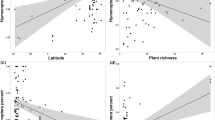Abstract
Statistical methods are formulated for fitting and testing percolation-based, spatio-temporal models that are generally applicable to biological or physical processes that evolve in spatially distributed populations. The approach is developed and illustrated in the context of the spread of Rhizoctonia solani, a fungal pathogen, in radish but is readily generalized to other scenarios. The particular model considered represents processes of primary and secondary infection between nearest-neighbour hosts in a lattice, and time-varying susceptibility of the hosts. Bayesian methods for fitting the model to observations of disease spread through space and time in replicate populations are developed. These use Markov chain Monte Carlo methods to overcome the problems associated with partial observation of the process. We also consider how model testing can be achieved by embedding classical methods within the Bayesian analysis. In particular we show how a residual process, with known sampling distribution, can be defined. Model fit is then examined by generating samples from the posterior distribution of the residual process, to which a classical test for consistency with the known distribution is applied, enabling the posterior distribution of the P-value of the test used to be estimated. For the Rhizoctonia-radish system the methods confirm the findings of earlier non-spatial analyses regarding the dynamics of disease transmission and yield new evidence of environmental heterogeneity in the replicate experiments.
Similar content being viewed by others
References
Aitkin M., Boys R.J., and Chadwick T. 2005. Bayesian point null hypothesis testing via the posterior likelihood ratio. Statistics and Computing 15: 217–230.
Bailey D.J., Otten W., and Gilligan C.A. 2000. Percolation, heterogeneity and the saprotrophic invasion of soil by the fungal plant pathogen Rhizoctonia solani. New Phytol. 146: 535–544.
Besag J., Green P.J., Higdon D., and Mengersen K. 1995. Bayesian computation and stochastic computation (with discussion). Statistical Science 10: 3–66.
Cox J.T. and Durrett R. 1988. Limit theorems for the spread of epidemics and forest fires. Stoch. Proc. Appl. 30: 171–191.
Deacon J.W. 1980. Introduction to Modern Mycology. Blackwells Science, Oxford.
Draper D. 1995. Assessment and propagation of model uncertainty (with discussion). J. Roy. Stat. Soc. B 57: 45–97.
Filipe J.A.N, Otten W., Gibson G.J., and Gilligan C.A. 2004. Inferring the dynamics of a spatial epidemic from time series data. Bulletin of Mathematical Biology 66: 373–391.
Filipe J.A.N. and Gibson G.J. 1998. Studying and approximating spatio-temporal models for epidemic spread and control. Phil. Trans. Roy. Soc. Lond. $B$ 353: 2153–2162.
Filipe J.A.N. and Gibson G.J. 2001. Comparing approximations to spatio-temporal models for epidemics with local spread. B. Math. Biol. 63: 603–624.
Gibson G.J. 1997a. Markov Chain Monte Carlo methods for fitting and testing spatio-temporal stochastic models in plant epidemiology. Applied Statistics 46: 215–233.
Gibson G.J. 1997b. Investigating mechanisms of spatio-temporal epidemic spread using stochastic models. Phytopathology 87: 138–146.
Gibson G.J. and Renshaw E. 1998. Estimating parameters in stochastic compartmental models using Markov chain Monte Carlo methods. IMA J. Math. Appl. Med. and Biol. 15: 19–40.
Gibson G.J., Gilligan C.A., and Kleczkowski A. 1999. Predicting variability in biological control of a plant-pathogen system using stochastic models. Proc. R. Soc. Lond. B 266: 1746–1753.
Glasbey C.A. and Martin, R.J. 1986. Exploratory and confirmatory plots of single-channel records. J. Neuroscience Methods 16: 239–249.
Gottwald T.R., Gibson G.J., Garnsey S.M., and Irey M. 1999. Examination of the effect of aphid vector population composition on the spatial dynamics of citrus tristeza virus spread via stochastic modeling. Phytopathology 89: 603–608.
Kleczkowski A., Bailey D.J., and Gilligan C.A. 1996. Dynamically generated variability in plant-pathogen systems with biological control. Proc. R. Soc. Lond. B 263: 777–783.
O’Neill P.D. and Roberts G.O. 1999. Bayesian inference for partially observed stochastic epidemics. J. Roy. Statist. Soc. A 162: 121–129.
O’Neill P.D. and Becker, N.G. 2001. Inference for an epidemic when susceptibility varies. Biostatistics 2: 99–108.
Otten W., Bailey D.J., and Gilligan C.A. 2004. Empirical evidence of spatial thresholds to control invasion of fungal parasites and saproptrophs. New Phytol. 163: 125–132.
Otten W., Filipe J.A.N., Bailey D.J., and Gilligan, C. A. 2003. Quantification and analysis of transmission rates for soil-borne epidemics. Ecology 84: 3232–3239.
Otten W., Filipe J.A.N., and Gilligan C.A. 2005. Damping-off epidemics, contact structure, and disease transmission in mixed-species populations. Ecology 86: 1948–1957.
Silvey S.D. 1970. Statistical Inference. Harmondsworth, Penguin Books Ltd.
Tierney L. 1994. Markov chains for exploring posterior distributions (with discussion). Annals of Statistics 22: 1701–1762.
Wissel C. 2000. Grid-based models as tools for ecological research. In Diekmann, U., Law, R. and Metz, J.A.J. (Eds.) The Geometry of Spatial Interactions: Simplifying Spatial Complexity. Cambridge, UK, Cambridge University Press. pp. 94–115.
Author information
Authors and Affiliations
Corresponding author
Rights and permissions
About this article
Cite this article
Gibson, G.J., Otten, W., N. Filipe, J.A. et al. Bayesian estimation for percolation models of disease spread in plant populations. Stat Comput 16, 391–402 (2006). https://doi.org/10.1007/s11222-006-0019-z
Received:
Accepted:
Issue Date:
DOI: https://doi.org/10.1007/s11222-006-0019-z




